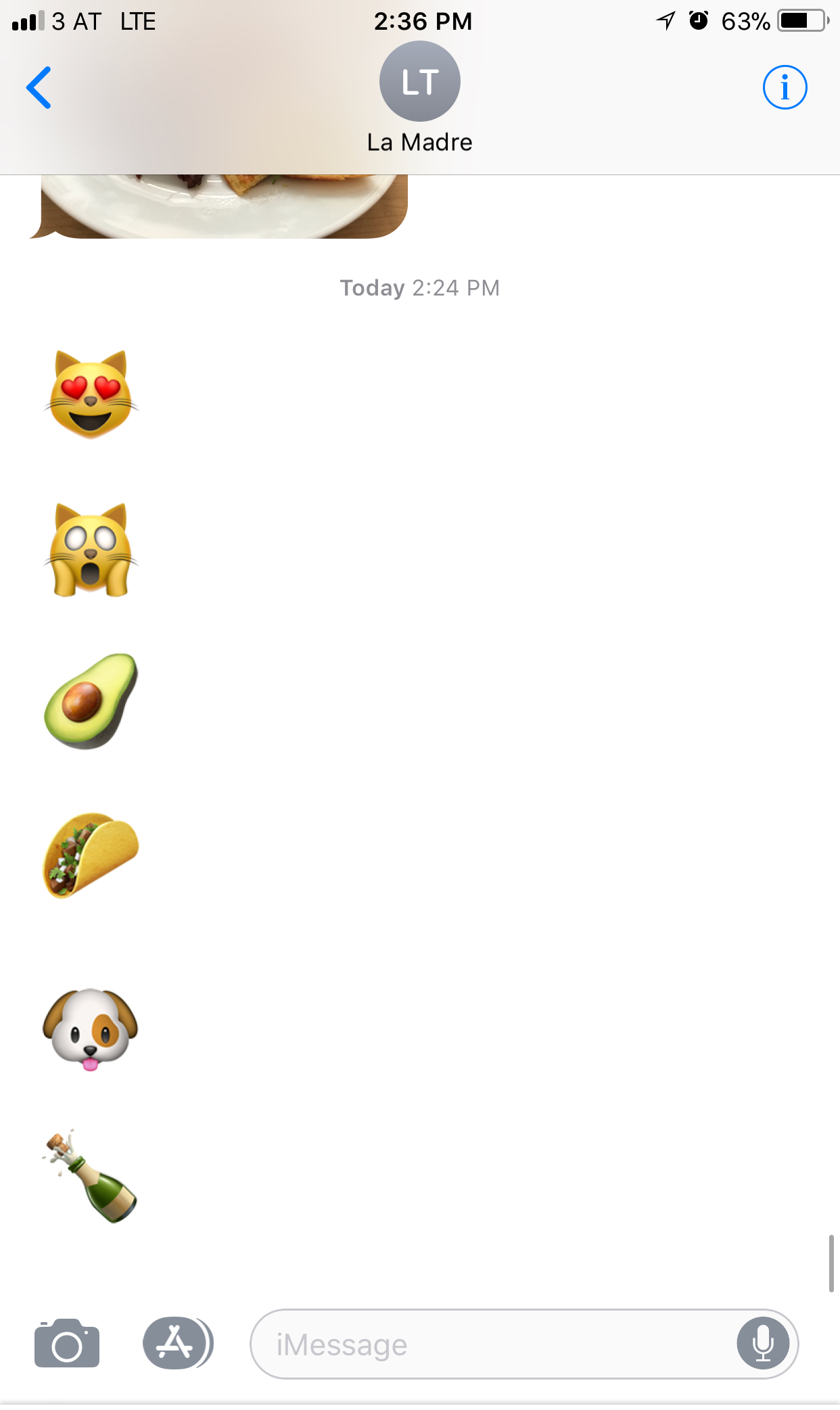True story, this is an actual text I got from my mom recently:

Um…yeah. I’m not sure what this means.
It might be some sort of code for “hey dude call your mother,” because I did, and the emojis didn’t actually come up.
Cryptic mom texts aside, emoji literacy is becoming something that digital marketers need to have on their radar. Emojis are one of the fastest growing “languages” in human history – and we’re seeing them make the leap from fun flair in SMS to mainstream marketing.
How emojis have crept into our vernacular
The modern emoji emerged in Japan in the late 1990s. The word “emoji” itself is actually a combo of the Japanese words for “picture” (e) and “character” (moji.)
There is truly nothing new under the sun, though — the first smiley face emoticons appeared on typewritten documents as far back as the 1648. (Yes, really. I mean it could have been a typo… read this and decide for yourself.)
The innovation of the smiley with a nose, i.e. :-), didn’t debut until 1982.
And now, here we are in 2017, scrolling through hundreds of itty bitty images our iPhone keyboards to find the emoji that perfectly captures the emotion we can’t quite explain in words. What a time to be alive.
Should you give emojis a try in your marketing?
We’re all looking for ways to stand out in a crowded inbox. Could a colorful image catch your recipient’s eye in a long list of text only subject lines?
According to a report by Experian, 56% brands using an emoji in their email subject lines saw a lift in unique open rate. Not too shabby. Other data I’ve seen on emoji performance has had inconclusive results. But it might be worth a try…
A few things to consider to help you determine whether this makes sense for your marketing:
1. Does it fit your brand voice?
What is the tone of your overall marketing and corporate comms? Is it buttoned up and formal? Light and playful? Somewhere in between? Keep your emoji-ing consistent with that, and use your brand guidelines as a filter for how and when to use a well-placed emoji.
2. Who else is doing it?
Scan your own inbox for emojis in emails. Is your competition leveraging them to stand out? If the answer is no – I actually see that as a really good thing. That means there’s an opportunity for you to differentiate.
3. How will you know if it’s working?
What’s the main metric you’re targeting? If you’re dropping emojis in subject lines, the best one would be open rate. This is an ideal use case for A/B testing, so that you can isolate the impact of the emoji.
Get your emoji on: HOW to actually do it
Ready to go? Then here’s the how-to stuff:
1. Copy and paste into your Pardot template ????♀️
The easiest way to get an emoji into Pardot is with a little Ctrl + C, Ctrl + V action. Emojipedia is a great resource to select the perfect emoji.
Update: Amy has brought it to my attention that not ALL emojis available on Emojipedia will work in Pardot. Working on testing this and coming up with a comprehensive list of “Pardot-safe” emojis, but in the meantime, here are some that have worked for me:
■ □ ▢ ▣ ▤ ▥ ▦ ▧ ▨ ▩ ▪ ▫ ▬ ▭ ▮ ▯ ▰ ▱ ▲ △ ▴ ▵ ▶ ▷ ▸ ▹ ► ▻ ▼ ▽ ▾ ▿ ◀ ◁ ◂ ◃ ◄ ◅ ◆ ◇ ◈ ◉ ◊ ○ ◌ ◍ ◎ ● ◐ ◑ ◒ ◓ ◔ ◕ ◖ ◗ ◘ ◙ ◚ ◛ ◜ ◝ ◞ ◟ ◠ ◡ ◢ ◣ ◤ ◥ ◦ ◧ ◨ ◩ ◪ ◫ ◬ ◭ ◮ ◯ ✁ ✂ ✃ ✄ ✆ ✇ ✈ ✉ ✌ ✍ ✎ ✏ ✐ ✑ ✒ ✓ ✔ ✕ ✖ ✗ ✘ ✙ ✚ ✛ ✜ ✝ ✞ ✟ ✠ ✡ ✢ ✣ ✤ ✥ ✦ ✧ ✩ ✪ ✫ ✬ ✭ ✮ ✯ ✰ ✱ ✲ ✳ ✴ ✵ ✶ ✷ ✸ ✹ ✺ ✻ ✼ ✽ ✾ ✿ ❀ ❁ ❂ ❃ ❄ ❅ ❆ ❇ ❈ ❉ ❊ ❋ ❍ ❏ ❐ ❑ ❒ ❖ ❘ ❙ ❚ ❛ ❜ ❝ ❞ ❡ ❢ ❣ ❤ ❥ ❦ ❧ ❶ ❷ ❸ ❹ ❺ ❻ ❼ ❽ ❾ ❿ ➀ ➁ ➂ ➃ ➄ ➅ ➆ ➇ ➈ ➉ ➊ ➋ ➌ ➍ ➎ ➏ ➐ ➑ ➒ ➓ ➘ ➙ ➚ ➛ ➜ ➝ ➞ ➟ ➠ ➡ ➢ ➣ ➤ ➥ ➦ ➧ ➨ ➩ ➪ ➫ ➬ ➭ ➮ ➯ ➲ ➳ ➴ ➵ ➶ ➷ ➸ ➹ ➺ ➻ ➼ ➽ ➾ ☀ ☁ ☂ ☃ ☄ ★ ☆ ☇ ☈ ☉ ☊ ☋ ☌ ☍ ☎ ☏ ☐ ☑ ☒ ☓ ☖ ☗ ☚ ☛ ☜ ☝ ☞ ☟ ☠ ☡ ☢ ☣ ☤ ☥ ☦ ☧ ☨ ☩ ☪ ☫ ☬ ☭ ☮ ☯ ☰ ☱ ☲ ☳ ☴ ☵ ☶ ☷ ☸ ☹ ☺ ☻ ☼ ☽ ☾ ☿ ♀ ♁ ♂ ♃ ♄ ♅ ♆ ♇ ♈ ♉ ♊ ♋ ♌ ♍ ♎ ♏ ♐ ♑ ♒ ♓ ♔ ♕ ♖ ♗ ♘ ♙ ♚ ♛ ♜ ♝ ♞ ♟ ♠ ♡ ♢ ♣ ♤ ♥ ♦ ♧ ♨ ♩ ♪ ♫ ♬ ♭ ♮ ♯ ♰ ♱
2. Understand how your emoji will come across (literally, not figuratively) ????
Be aware that emoji support across clients and operating systems is different. Emojis are based on Unicode characters – which is a computing industry standard that helps ensure consistent representation of text and symbols across digital devices.
For example, 8.2% of users are still on Windows XP, which is wholly e-NO-ji. If these folks get your email on a desktop client, they’ll see a big fat ☐ in place of the witty emoji you lovingly selected. The BEST environment for emojis is Gmail, which always renders emojis (no matter what device or OS.)
You could spend days analyzing how your emojis will render, but is that the highest and best use of your time as a marketer?
My advice would be to look at the top 3 OS and mail clients your audience is using, and allow that to inform your decision. Emojipedia show you what will come across.
3. Use emojis to accent, not replace content ????
Because you can’t be 100% certain that your emojis will render, I’d recommend using them for flair/emphasis rather than actually replacing words. So instead of:
Wanna ????this?
Try…
Wanna pizza this? ????
If your content is blocked, that latter is much easier to understand. The user will see:
Wanna pizza this? ☐
Instead of:
Wanna ☐ this?
That’s not a blank I’d want to leave to the human imagination. Lots of ways to fill that one in.
4. Treat it like an experiment, and TEST IT!
Don’t just listen to your ![]() .
.
Get some data.
Use your A/B testing superpowers (available in Pardot Pro or higher) to gather data on how emojis actually move the needle on your results. If you do run an emoji test, please share what you find in the comments!
Emoji or NOji: what are your thoughts?
If you do run an emoji test, please share what you find in the comments!
In the meantime, what do you think — are emojis a fun way to stand out in the inbox, or too cutesy for B2B marketing? When is a well placed emoji appropriate?










Great article. I really want to try this in Pardot but when I put an emoji in my subject line it says “Your content contains unsupported characters. Please remove all emoji, pictograph, and symbol characters” Bummer. We have the Pro Edition.
Hm interesting, it’s worked for me in the past. What emoji were you trying to use? Could you share a screenshot of the message? I’m wondering if there are Pardot safe/non-safe ones…
Thanks for replying! I was trying to use one from emojipedia. Perhaps I will try a few others and see if that changes anything. Good to know it works!
Amy — I just played around with some emojis from Emojipedia, and you’re 100% right. They don’t all work.
The good news: I updated the blog to include some “safe” ones to get started with, and will keep testing and adding to that list.
Bad news: no ????s…
That’s great! Thanks so much! (too bad about the tacos though…can you imagine the open rates?)
Hi Andrea,
Finally I find a post regarding the emoji issue 🙂
I have been testing and what I found is that you can use any emoji included in the version of Unicode 5.2 or below (well, I didn´t try every emoji of each version).
Any of the followings should work:
https://emojipedia.org/unicode-5.2/
https://emojipedia.org/unicode-5.1/
https://emojipedia.org/unicode-5.0/
https://emojipedia.org/unicode-4.1/
https://emojipedia.org/unicode-4.0/
https://emojipedia.org/unicode-3.2/
https://emojipedia.org/unicode-3.2/
https://emojipedia.org/unicode-3.1/
https://emojipedia.org/unicode-3.0/
https://emojipedia.org/unicode-1.1/
Your safe list put me on the track.
Thank you.